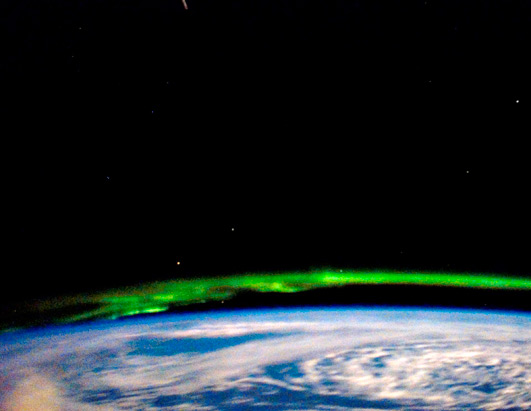Space.gs
Adv. Thin Ionizat. Calorimeter (ATIC): Unidentified Source of Nearby Cosmic Rays.
By Steve Cole, NASA Headquarters, 11/20/08

• Science:
Discovered: Cosmic Rays from a Mysterious, Nearby Object
- An artist's concept of cosmic rays hitting Earth's upper atmosphere. Credit: Simon Swordy, University of Chicago. NASA Astr. Photo Of the Day:
Cosmic Rays
Scientists announced on Wednesday the discovery of a previously unidentified nearby source of high-energy cosmic rays. The finding was made with a NASA-funded balloon-borne instrument high over Antarctica. Researchers from the Advanced Thin Ionization Calorimeter (ATIC) collaboration, led by scientists at Louisiana State University, Baton Rouge, published the results in the November 20 issue of the journal Nature. The new results show an unexpected surplus of cosmic ray electrons at very high energy - 300-800 billion electron volts - that must come from a previously unidentified source or from the annihilation of very exotic theoretical particles used to explain dark matter.
'This electron excess cannot be explained by the standard model of cosmic ray origin,' said John P. Wefel, ATIC project principal investigator and a professor at Louisiana State. 'There must be another source relatively near us that is producing these additional particles.' According to the research, this source would need to be within about 3,000 light years of the sun. It could be an exotic object such as a pulsar, mini-quasar, supernova remnant or an intermediate mass black hole.
 - The ATIC cosmic ray detector is prepared in the Antarctica by scientists to ascend to the stratosphere tethered to a high-altitude research balloon.
- The ATIC cosmic ray detector is prepared in the Antarctica by scientists to ascend to the stratosphere tethered to a high-altitude research balloon.
'Cosmic ray electrons lose energy during their journey through the galaxy,' said Jim Adams, ATIC research lead at NASA's Marshall Space Flight Center in Huntsville, Ala. 'These losses increase with the energy of the electrons. At the energies measured by our instrument, these energy losses suppress the flow of particles from distant sources, which helps nearby sources stand out.' The scientists point out, however, that there are few such objects close to our solar system.
'These results may be the first indication of a very interesting object near our solar system waiting to be studied by other instruments,' Wefel said. An alternative explanation is that the surplus of high energy electrons might result from the annihilation of very exotic particles put forward to explain dark matter. In recent decades, scientists have learned that the kind of material making up the universe around us only accounts for about five percent of its mass composition. Close to 70 percent of the universe is composed of dark energy (so called because its nature is unknown). The remaining 25 percent of the mass acts gravitationally just like regular matter, but does little else, so it is normally not visible.
 - The ATIC cosmic ray detector ascends to the stratosphere tethered to a high-altitude research balloon.
- The ATIC cosmic ray detector ascends to the stratosphere tethered to a high-altitude research balloon. More launch images:
1
The nature of dark matter is not understood, but several theories that describe how gravity works at very small, quantum distances predict exotic particles that could be good dark matter candidates. 'The annihilation of these exotic particles with each other would produce normal particles such as electrons, positrons, protons and antiprotons that can be observed by scientists,' said Eun-Suk Seo, ATIC lead at the University of Maryland, College Park.
The 4,300-pound ATIC experiment was designed to be carried to an altitude of about 124,000 feet above Antarctica using a helium-filled balloon about as large as the interior of the New Orleans Superdome. The goal was to study cosmic rays that otherwise would be absorbed into the atmosphere.
ATIC is an international collaboration of researchers from Louisiana State University, the University of Maryland, Marshall Space Flight Center, Purple Mountain Observatory in China, Moscow State University in Russia and the Max Planck Institute for Solar System Research in Germany. ATIC is supported in the United States by NASA and flights are conducted under the auspices of the Balloon Program Office at NASA's Wallops Flight Facility in Virginia by the staff of the Columbia Scientific Balloon Facility. Antarctic logistics are provided by the National Science Foundation.
____

On the Net:
Science Discoveries:
http://science.nasa.gov
Metereologiest Dave Murray's Blog:
Myfoxstl.com/blogs












 • Science: Discovered: Cosmic Rays from a Mysterious, Nearby Object
• Science: Discovered: Cosmic Rays from a Mysterious, Nearby Object


 - Shuttle Endeavour Wikip.
- Shuttle Endeavour Wikip. • http://earth.jsc.nasa.gov
• http://earth.jsc.nasa.gov  » Photos » Live: NASA TV
» Photos » Live: NASA TV